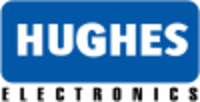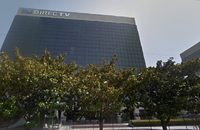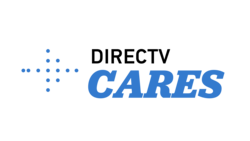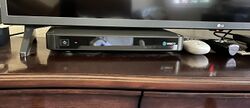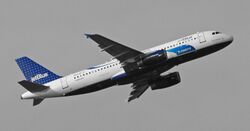DirecTV
Topic: Company
 From HandWiki - Reading time: 30 min
From HandWiki - Reading time: 30 min
Logo since August 2, 2021 | |
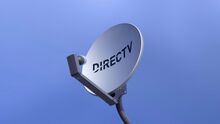 | |
| Formerly | The DirecTV Group, Inc. (2005–2015) |
|---|---|
| Type | Joint venture |
| NASDAQ: DTV | |
| Industry | Multichannel video programming distributor |
| Predecessor | Hughes Electronics |
| Founded | June 17, 1994 (as DirecTV) |
| Headquarters | El Segundo, California , |
Areas served | United States, Latin America, the Caribbean and Europe |
| Products | multichannel linear pay television |
| Owners |
|
| Subsidiaries | U-verse TV DirecTV Stream |
| Website | www |
| Footnotes / references [1] | |
DirecTV (trademarked as DIRECTV) is an American multichannel video programming distributor based in El Segundo, California . Originally launched on June 17, 1994, its primary service is a digital satellite service serving the United States. It also provides traditional linear television service delivered by IP through its U-verse TV brand and a Virtual MVPD service through its DirecTV Stream brand.[2] Its primary competitors are Dish Network, traditional cable television providers, IP-based television services, and other over-the-top video services.
On July 24, 2015, after receiving approval from the Federal Communications Commission and the Department of Justice, AT&T acquired DirecTV in a transaction valued at $67.1 billion.[3][4]
As of the end of Q1 2021, AT&T had 15.9 million pay-TV customers, including DirecTV, U-Verse, and DirecTV Stream subscribers.[5]
On February 25, 2021, AT&T announced that it would spin-off DirecTV, U-Verse TV, and DirecTV Stream into a separate entity, selling a 30% stake to TPG Inc., while retaining a 70% stake in the new standalone company. The deal closed on August 2, 2021.[6][7]
History
Hughes Electronics
In 1953, Howard Hughes created the Howard Hughes Medical Institute (HHMI), to which he transferred full ownership of Hughes Aircraft.[8] Following Hughes' death in 1976, HHMI was incorporated in 1977, and litigation ensued to determine whether it would be allowed to maintain its interest in Hughes Aircraft.[9] In 1984, the court appointed a new board for HHMI, which proceeded to sell off Hughes Aircraft to General Motors on December 20, 1985, for an estimated $5.1 billion.[10] General Motors then merged Hughes Aircraft with its subsidiary Delco Electronics to create Hughes Electronics Corporation.[11]
Stanley E. Hubbard founded United States Satellite Broadcasting (USSB)[12] and was a leading proponent for the development of direct-broadcast satellite service in the United States.[13] HHMI and other companies believed in the early 1990s that technology would soon make digital satellite television affordable.[14] HHMI created DIRECTV as a separate division and secured an agreement with USSB to build and launch the first high-power direct-broadcast satellite system.[15][16]
Direct satellite broadcasters were mandated in 1992 to set aside 4% of its channel space for noncommercial educational and informational programming. DirecTV selected C-SPAN , EWTN and the Trinity Broadcasting Network from its current channel lineup plus request additional proposals from other programmers. DirecTV had given PBS Kids, PBS's original application, carriage that did not count against the set aside six weeks before the deadline. DirecTV selected an additional six channels; Clara+Vision, Inspirational Life, NASA TV, PBS YOU, StarNet and WorldLink TV, for the mandate.[17]
The USSB and DirecTV programming services were launched on June 17, 1994.[18]
On November 11, 1997, DIRECTV signed a two-year deal with Action Adventure Network to offer original series and telefilms for pay-per-view viewing, for $2.99 with the intent to expand.[19]
In December 1998, DirecTV acquired USSB for $1.3 billion, and combined the two satellite services.[20] In 1999, DirecTV acquired PrimeStar, a competitor in the satellite television industry, for $1.83 billion, dramatically increasing its share of the satellite television market in the US.[21]
In 2000, DirecTV introduced the first live in-flight television service for airlines; the system was first used by JetBlue and defunct startup carrier Legend Airlines.[22]
On April 9, 2003, News Corporation, the then-parent company of 20th Century Fox (now known as 20th Century Studios) and Fox Television Studios, agreed to purchase a 34% controlling interest in Hughes, including GM's entire share of the company, for $6.6 billion, subject to SEC approval.[23] The FCC voted 3–2 along party lines on December 19, 2003, to approve the deal subject to conditions, forcing News Corp. to agree to arbitration for all disputes with carriers of its media broadcasters, and to provide content through DirecTV neutrally rather than favoring its own networks.[24]
In February 2004, Hughes announced its intent to focus solely on its satellite television operations and divest its other interests, renaming itself The DirecTV Group, Inc. on March 16, 2004, and changing its ticker symbol from "HS" to "DTV".[25] In April of that year, it sold its controlling interest in PanAmSat to a private consortium led by Kohlberg Kravis Roberts for $3.53 billion.[26] On April 22, 2005, DirecTV spun off Hughes Network Systems into a separate entity and sold 50% of the new entity to SkyTerra, acquiring $157.4 million in the transaction.[27] In January 2006, DirecTV sold its remaining 50% share in Hughes Network Systems to SkyTerra for $100 million.[28]
In 2004, DIRECTV exited the Mexican market, even though it maintained 41% ownership of SKY México.[29] On November 15, 2005, DirecTV stopped carrying Music Choice audio-only channels, replacing it with 73 channels of XM Satellite Radio. In 2007, DIRECTV exited the Brazilian market, with the customers being migrated to the 74% DirecTV-owned Brazilian affiliate of SKY Brasil.[29]
On November 1, 2005, DirecTV made its foray with its first original series, CD US, on Freeview.[30] In December 2005, the U.S. Federal Trade Commission imposed a $5.3 million penalty on DirecTV for its violations of federal telemarketing regulations. It was the largest civil penalty the FTC had ever announced in a case enforcing any consumer protection law.[31]
In December 2006, News Corporation announced its intention to transfer its 38.5% controlling interest in The DirecTV Group, four regional Fox Sports Net stations, and $550 million cash to Liberty Media in exchange for Liberty's 19% interest in News Corp.[32] The deal, valued at $11 billion, was approved by News Corp. shareholders.[33][34][35]
On January 9, 2007, DirecTV announced it would introduce up to 100 national HD channels during 2007, all of which would be MPEG-4 encoded.[36]
On December 13, 2007, DirecTV purchased most of the assets of ReplayTV from D&M Holdings.[37]
In September 2008, consumers filed a class action lawsuit with the Los Angeles Superior Court to stop DirecTV's practice of charging early cancellation penalties to subscribers. In September 2009, a motion for a preliminary injunction was filed to block the company from automatically removing the fees from customers' bank accounts or charging their credit card accounts without their prior knowledge and written consent.[38] In 2009, the Washington Attorney General's office filed a civil complaint against DirecTV, finding that the company allegedly engaged in numerous repeated violations of the state's Consumer Protection Act. Violations included: unclear rebate terms and conditions, unfair advertisement, and automatically extending customer contracts.
On May 4, 2009, Liberty announced that it would split off Liberty Entertainment, Inc., and Liberty's 65% interest in Game Show Network, into a separate company to be merged with The DirecTV Group.[39] The merger was completed on November 19, 2009, with The DirecTV Group and Liberty Entertainment becoming subsidiaries of a new company named DIRECTV.[40] On June 16, 2010, Malone exchanged his preferred stock in DirecTV with equivalent amounts of common stock, with Malone ending his managerial role at DIRECTV.[41]
On February 9, 2010, DirecTV dropped Sirius XM Radio and replaced the channel lineup with Sonic Tap audio stations.[42] On April 1, 2011, DirecTV announced it would be renaming its three Bally Sports channels as Root Sports, though the channels were still affiliated with Bally Sports.[43]
The case brought by Washington state was settled in December 2010, with DirecTV agreeing to pay over $1 million.[44] DirecTV subsequently settled a similar suit with the other 49 states and the District of Columbia for $13.25 million.[45][46]
In June 2013, DirecTV purchased Pennsylvania-based LifeShield, a maker of wireless home security systems, with plans to market the systems to its customers.[47]
On May 18, 2014, AT&T announced that it would purchase DIRECTV for approximately $67.1 billion.[48][49] The acquisition was officially approved by the FCC in 2015; it was subject to conditions for four years, requiring AT&T to expand its fiber-optic broadband service to additional customers, public libraries, and schools, and to "refrain from imposing discriminatory usage-based allowances or other discriminatory retail terms and conditions on its broadband internet service".[50][51]
On March 11, 2015, the Federal Trade Commission filed a lawsuit against DIRECTV for deceptive advertising. The FTC claimed that DIRECTV failed to properly disclose terms of its TV packages, such as contractual obligations and premiums.[52]
On December 2, 2015, DIRECTV adopted a new logo, replacing its previous emblem with that of AT&T.[53][54][55]
In February 2016, Bloomberg reported that AT&T was in the process of phasing out the U-verse IPTV service by encouraging new customers to purchase DirecTV satellite service instead, and by ending the production of new set-top boxes for the service. AT&T CFO John Stephens had also previously stated that DirecTV's larger subscriber base as a national service gave the service a higher degree of leverage in negotiating carriage deals, thus resulting in lower content costs.[56][57][58]
On March 1, 2016, AT&T announced plans for several DirecTV-branded over-the-top services, including AT&T TV, DIRECTV Mobile, and DIRECTV Preview to be offered under one platform called DIRECTV Stream.[59][60][61] DIRECTV Stream launched on November 30, 2016, and was directly competing against Sling TV.[62][63]
On October 20, 2016, it was reported that AT&T was in talks to acquire Time Warner, in an effort to increase its media holdings.[64][65][66] On October 22, 2016, AT&T reached a deal to buy Time Warner for over $80 billion. The merger was approved by federal regulators, bringing DirecTV under the same umbrella as HBO, Cinemax, Turner Broadcasting System, Warner Bros., and Telepictures.[67][68]
On July 13, 2017, it was reported that AT&T would introduce a cloud-based DVR streaming service as part of its effort to create a unified platform across DIRECTV and its DIRECTV Stream service.[69][70][71]
On July 30, 2019, DirecTV Now customers received notices saying the name of that service had been changed to AT&T TV Now,[72] and AT&T CEO Randall Stephenson said DirecTV will continue to operate even after the launch of AT&T TV.[73][74]
On February 25, 2021, AT&T announced that it would spin-off DirecTV, U-Verse TV, and DirecTV Stream into a separate entity, selling a 30% stake to TPG Inc., while retaining a 70% stake in the new standalone company. The deal closed on August 2, 2021.[6][7]
DIRECTV Stream, which offers Live TV and On Demand content, launched in August 2021.[75] Soon after, DIRECTV’s “Get Your TV Together” ad campaign launched, which featured Serena Williams and cast members of The Real Housewives alongside NFL players.[76][77]
In January 2022, the Los Angeles Sports & Entertainment Commission announced that DIRECTV would serve as Presenting Sponsor of The Chairman’s Party, a Super Bowl after-party inside SoFi Stadium.[78]
DIRECTV completed its national rollout of local PBS member stations in February 2022. Nearly 250 local PBS stations in 198 Nielsen DMAs were added that reach 99% of all U.S. TV homes.[79]
In February 2023, DIRECTV presented and sponsored the third annual American Cornhole League (ACL) Pro Shootout Series, where Tyler Lockett represented DIRECTV.[80]
In April 2023, DirecTV launched a brand campaign, “Overly Direct Spokesperson,” that stars Brian Cox; this is part of its new brand strategy platform, “Entertainment Without Compromise”.[81]
Partnerships
Since 2022, DIRECTV has partnered with Ronald McDonald House Charities and its network of local chapters.[82] DIRECTV has also partnered with the Hispanic Federation, Kids in the Spotlight, the Los Angeles Sports & Entertainment Commission, and the Plus Me Project.[83][84][85]
Yahoo and DIRECTV announced an advertising deal in June 2022; under this partnership, Yahoo’s omnichannel demand-side platform provided advertisers access to DIRECTV’s programmatic inventory on linear addressable and connected TV platforms while DIRECTV gained access to Yahoo’s supply-side platform, making its streaming inventory available across the Yahoo Exchange.[86][87]
In August 2022, DIRECTV and Amazon Prime announced a multi-year agreement for airing NFL Thursday Night Football games in over 300,000 venues. Amazon Prime holds exclusive rights to TNF games for 12 seasons beginning in 2022.[88] DIRECTV is also the national provider of MLS Season Pass, a new subscription service from Apple and Major League Soccer, to commercial establishments such as bars, lounges and restaurants. The offering is known as DIRECTV for Business.[89]
Yahoo expanded its partnership with DIRECTV advertising to include set-top box data in October 2022.[90]
In June 2023, Southwest Airlines and DIRECTV partnered together to support RMHC by providing meals for families staying at the Ronald McDonald House in Dallas, Texas.[91] The same month, DIRECTV announced a multi-year renewal of its affiliation agreement with NFL Media that will extend its existing carriage of NFL Network on DIRECTV and will add distribution via DIRECTV Stream and U-verse.[92]
In August 2023, Big Ten Network and Big Ten Conference announced a multi-year sponsorship agreement with DIRECTV.[93]
DIRECTV became the exclusive provider of NFL Sunday Ticket across Puerto Rico and the U.S. Virgin Islands in September 2023.[94]
DIRECTV is sponsoring the US Baseball Team in the 2023 World Baseball Classic.[95]
Satellites
(As of February 2020), DirecTV manages a fleet of 12 satellites in geostationary orbit at positions ranging from 95°W to 119°W, ensuring strong coverage of the North American continent.
Devices
Launch (1994–1998)
DIRECTV’s initial service offering was characterized by the delivery of all-digital standard definition national channels to locations in the lower 48 states. This allowed households without available cable television service to receive national channels. In these early years, receivers were manufactured with brands including RCA and GE (Thomson of France) and Sony Electronics.[96] When DIRECTV launched a few High Definition channels in the late 1990s, other CE manufacturers joined in with HD capable receivers under their own brands which helped promote sales of their early generation HD television products. These additional company brands included Samsung Electronics, Philips, Panasonic, Mitsubishi Electronics, and Toshiba.[96] Features that were innovative at the time included: a fully interactive program guide, parental controls (i.e. allowed parents to passcode protect channels having R-rated content), and pay-per-view (allowing rentals via remote control instead of having to call DIRECTV for authorization). The initial generation of antennas was 18-inch diameter (46 cm) with a single feed (consisting of a feedhorn and LNB electronics) that could downlink digital television signals from DIRECTV’s satellites at the 101 degrees West geostationary orbital position.[97]
Locals era (1999–2003)
DIRECTV receiver modifications accommodated local channels, including multi-orbital slot reception and an improved electronic program guide featuring TV listings up to two weeks. The first locals-era DIRECTV outdoor antenna was a follow-up generation with a 18x24-inch diameter (46x61 cm) elliptical reflector and three feeds that additionally allowed “multi-sat” reception from DIRECTV satellites at the 119W and 110W positions.
HD (1999–2003)
DIRECTV launched new network components dedicated to HD channels. The new network components allowed DIRECTV to address challenges with customers experiencing different user interfaces depending on the brand of DIRECTV receiver they used, by specifying a “common user experience.” DIRECTV’s designs were built with companies including Pace Micro Technology of Britain, LG of South Korea (which had manufactured boxes under the LG and Zenith Electronics names), Thomson, GE (under license), and ProScan.[96]
DIRECTV’s initial satellites used Ku band frequencies. With the launch of new satellites utilizing Ku band frequencies, DIRECTV increased its available signal bandwidth more than six-fold to meet the requirements of the higher resolution HD television pictures. DIRECTV also maintained its original fleet of satellites in operation at 101W, 110W and 119W longitudes and simulcasted the SD and HD versions of channels once made available. These new DIRECTV HD channels required an H20/HR20 or later model set top box (STB) capable of supporting the MPEG-4 standard for HD programming. These models also introduced HDMI support for HDTVs with an HDMI port. A new “Slimline” outdoor antenna design was introduced, capable of receiving both the Ka Band satellites located at 99W and 103W longitude as well for a total of 5 LNBs. Over time, DIRECTV has consolidated HD programming onto solely the 99W, 101W and 103W slots allowing for the use of a Slimline antenna having 3 LNBs instead of 5.
Genie (2008–2013)
Video On-Demand (VOD) features were enabled, allowing a viewer to “start over” a program, “look back” at a program that had recently aired, watch prior episodes that weren't presently aired, and see advertising according to that viewer’s characteristics. “Whole-home” viewing allowed viewers to access and view their DVR recordings from any room in the house, not just the room where the DVR receiver was located.
In 2012, DIRECTV launched its “Genie” family of receiver models, consisting of a “Genie” home server and “mini Genie” devices. Having 5 satellite tuners, the Genie offered live viewing of up to four channels while simultaneously recording a program on a fifth channel. Up to eight mini-Genies could be installed in a home, however simultaneous live viewing was possible on any four of the devices (including the Genie itself).[98][99]
In addition, DIRECTV integrated WiFi wireless home networking to connect set-top boxes to broadband services. DIRECTV incorporated RVU remote user interface technology, allowing a single DIRECTV receiver to transmit both video/audio and user screen direction to compatible television sets.[100] DIRECTV also developed capabilities to “download and go” DVR recordings (“GenieGo”) and to stream recordings to devices while out of home.
2014–present
DIRECTV introduced limited 4K UltraHD and High Dynamic Range broadcasts. The first nationwide 4K UltraHD broadcasts were made available by DIRECTV, and DIRECTV offered large sporting events in the format as well as PPV movie rentals and 4K channels. The 4K capable DIRECTV miniGenie client (model C61K-700) also became available.[100]
A “Genie 2” device, HS17, was introduced in 2017 that added more satellite tuners and integrated the WVB functionality.[101]
DIRECTV began delivering broadband-only services requiring no DIRECTV branded equipment whatsoever. Under its new owner AT&T, mobile-device-only television packages were developed (i.e. WatchTV). The DIRECTV Stream device (model C71KW) became available in 2019 to customers of over-the-top (OTT) streaming service.[102]
In 2023, DIRECTV released GEMINI, combining mini-Genie capabilities with the same features developed for the DIRECTV Stream device.[103]
Access card history
DirecTV transmits programming with encryption to mitigate signal piracy. The receiver (also known as an IRD, or "integrated receiver-decoder") utilizes ISO/IEC 7816 smart cards which tell the receiver how to decrypt the programming for viewing. In a continuing effort to combat piracy, an access card generation is created approximately every two years, superseding the old set. DirecTV is now utilizing the fifth generation of access cards.
- P1, also known as F cards, were used until 1997. F cards have a picture of a satellite and the DSS logo on the front.
- P2, also known as H cards, were introduced in 1996 and eventually replaced F cards. H cards look the same as F cards. H cards were in use until 2002.
- P3, also known as HU cards, were introduced in 1999 and were used until April 2004. HU cards have a picture of a football player, a basketball, a clapperboard, and a film canister on the front. HU cards originally shipped with receivers with serial numbers above 0001 700 000. These were removed from circulation because piracy plagued the system.
- P4 cards were introduced in 2002 and are currently still in use. P4 cards are labeled "Access Card: 4."
- D1 cards were introduced in 2004 following compatibility problems with the P4 cards in some receivers. These cards can be identified by the silver edges, and simply bear the word "DirecTV" on the front (no number). Usually found on DirecTV TiVo Series 2 DVRs (DirecTiVos), the D10 and H10 series receivers.
- D2/P12 cards were introduced in 2005. D2 cards can be identified by a two-toned blue dot pattern resembling the DirecTV logo in addition to the DirecTV logo and the words "DirecTV Access Card," while the P12 card has a picture of a satellite on the front. The P12 card is the only card that will work with R15, H20, and HR20 series receivers.
- O cards are the current "standard issue" card. They can be identified with the words "Now part of the AT&T family."
DirecTV has battled with an active signal piracy underground for many years. One infamous event that temporarily hampered pirates was known as 'Black Sunday', which took place one week before Super Bowl Sunday in 2001. Hackers saw a string of software updates starting in late 2000 which each contained a few innocuous bytes. However, when the innocuous bytes from all those updates were combined, they became code that searched for and destroyed 98% of hacked smart cards and then wrote the text "GAME OVER" to the first 8 bytes of the hacked cards memory. Hacks continued after that event.[104][105][106] [107]
High-definition television (HDTV)


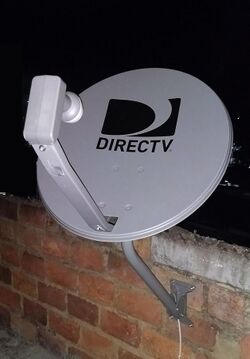
Like its competitors, DirecTV offers high-definition television (HDTV) and interactive services.
To handle the proliferation of bandwidth-intensive HDTV broadcasting, DirecTV rebroadcasts local HDTV stations using the H.264/MPEG-4 AVC codec while employing a newer transmission protocol (DVB-S2) over the newer satellites. This allows DirecTV to squeeze much more HD programming over its satellite signal than was previously feasible using the older MPEG-2 compression and DSS protocol it has been using. This technology will be gradually expanded to the existing satellites as customer equipment is replaced with new MPEG-4-capable receivers.
Receiving channels encoded in MPEG-4 requires newer receivers, such as the H20 as well as the 5-LNB Ka/Ku dish. DirecTV has contracted with Britain's Pace Micro Technology, Korea's LG Electronics and France's Thomson to manufacture these new receivers. Pace manufactures the DirecTV Plus HD DVR (Model HR20-700, and HR21-700) and LG Electronics offers the Model H20-600 receiver, while Thomson provides the Model H20-100 and HR20-100 DVR receivers. DirecTV has admitted to software issues with some of the H20 receivers and HR20 DVRs, which have been plagued with random problems since they were released in mid-2006. DirecTV regularly released software updates for the HR20 receivers, in an effort to reduce issues to an acceptable level.
DirecTV has phased out its original TiVo-branded HD DVR, the HR10-250, which can only decode the older MPEG-2 signals. All DirecTV-delivered local HDTV stations (outside of the NYC and LA network stations) are encoded in MPEG-4. The HR10-250 cannot receive the MPEG-4 local HDTV stations in these markets but can still receive over-the-air ATSC broadcasts in these markets. After a multi-year hiatus, TiVo and DirecTV are developing a new TiVo-enabled HD DVR that will be able to receive/decode DirecTV's current MPEG-4 satellite signals. Originally slated for release in the second half of 2009, it is now available in select markets.[108][109]
4K television
In November 2014, DirecTV became the first television provider to begin offering 4K ultra-high definition content. On launch, 4K content was limited to renting a small library of on-demand films, downloaded to the subscriber's Genie DVR (some 4K content can also be pre-loaded automatically to the set-top box via the Genie Recommends feature). The 4K service could also only be used on "DirecTV 4K Ready" televisions, which support RVU protocol; this was limited to selected Samsung 4K televisions released in 2014.[110]
In 2015, DirecTV introduced 4K Genie Mini set-top boxes, which can be connected to any HDMI 2.0/HDCP 2.2-compliant devices to provide 4K video.[111]
In April 2016, DirecTV began live sports broadcasts in 4K to eligible subscribers, including coverage from the 2016 Masters Tournament,[112][113] 25 MLB Network Showcase baseball games in the 2016 season (subject to local blackout restrictions) beginning April 15, 2016,[114] and all Notre Dame college football home games during the 2016 season.[115]
Local channels
DirecTV offers local channels like CBS, ABC, NBC, Fox, MyNetworkTV, The CW, Telemundo, Univision, UniMás, and independent stations in markets covering over 99.2% of U.S. TV households.[116] In markets that lack an OTA CW affiliate, DirecTV offers The CW Plus or KTLA from Los Angeles (both only in standard definition). Because DirecTV does not carry local digital subchannels, broadcast networks such as MeTV and Heroes & Icons are not available on DirecTV in most markets.
Subscribers located in areas that cannot receive an adequate terrestrial television signal and/or who live in a small market that only has a couple of stations can receive feeds from New York and Los Angeles for CBS, ABC, NBC, and Fox, as well as a feed from the CW Plus, though a waiver from the local affiliate stations may be required to allow this, approved at their discretion. National PBS (through the PBS Satellite Service) and Ion Television channels are also available.
In the largest markets, local channels are carried on the satellite at 101°W. In some smaller markets, the local channels are carried on a second satellite located at 119°W which requires a slightly larger dish with two or three LNBs or the newer Ka/Ku 5-LNB dish. In a few smaller markets, local stations are located on a satellite at 72.5°W that requires a second dish to be installed.
In late 2005, DirecTV began providing local HDTV channels to the largest markets, requiring newer receivers with a larger dish capable of receiving signals from up to five satellites at once. The Ku-band signals on the newer Ka/Ku dish are received from 101°W, 110°W, and 119°W, while Ka-band signals are from 99°W and 103°W.
Local television channels are transmitted over optical fiber links, Ku-band satellite uplink, microwave, and conventional terrestrial transmission to uplink centers located throughout the United States.
Programming
DirecTV's exclusive general entertainment channel Audience Network had dozens of original and acquired programs. The channel ceased operations in 2020. Separately, DirecTV had its own exclusive 3DTV channel called n3D that launched in 2010 and shut down in 2012.
DirecTV serves American Airlines, Delta Air Lines, JetBlue, Southwest Airlines, and United Airlines.
DirecTV previously owned the regional sports networks AT&T SportsNet Pittsburgh, AT&T SportsNet Southwest, AT&T SportsNet Rocky Mountain, and Root Sports Northwest (all under the umbrella of AT&T Sports Networks). It also owned minority shares of Game Show Network and MLB Network. DirecTV was also the exclusive U.S. rights holder to the NFL Sunday Ticket, from the sports package's debut in the 1994 NFL season to the 2022 NFL season, before YouTube TV picked up NFL Sunday Ticket for the 2023 NFL season. It also exclusively carries the "DirecTV Experience", which includes bonus coverage of men's major golf tournaments and Grand Slam tennis tournaments, including live feeds not available on other networks such as CBS (formerly), NBC, ESPN, Golf Channel and Tennis Channel that cover the events. DirecTV was also the exclusive provider of defunct sports packages NASCAR Hot Pass and Mega March Madness.
DirecTV offers movie and special event programming through the DirecTV Cinema service; originally a pay-per-view service (with programs purchased either over the phone, or via remote if a phone line was connected to the DirecTV receiver), advances in technology have enabled DirecTV to expand into a true video on demand service; access to this service requires an internet connection.
Sports packages for businesses
With streaming providers such as ESPN+ and Amazon Prime Video signing deals to exclusively stream selected sports events, DirecTV has become an alternative for commercial establishments, such as bars, restaurants and casinos, to show these games. This provides a loophole in the streaming providers' licensing terms that normally prohibit their commercial use in commercial establishments where the business makes money. In addition, these establishments do not have to reconfigure their systems to accommodate a streaming-only platform.[117]
Beginning in 2021, DirecTV became an exclusive provider of ESPN+ for Business, which carries limited live sporting events that are otherwise streamed on a ESPN+ consumer account. This package is sold directly by Joe Hand Promotions.[118] On August 23, 2022, Amazon and DirecTV entered into a multi-year carriage agreement to broadcast Thursday Night Football only to business customers at no extra cost.[117] In 2023, it was announced that DirecTV would retain exclusive rights to NFL Sunday Ticket for business customers only.[119]
Marketing
Beginning in 2006, DirecTV began a series of commercials in which characters from popular movies and television shows break the fourth wall to tout the service's picture quality and the number of channels available in high definition. Instead of using CGI, the original actors normally reprise their roles on recreated sets, and resulting footage is mixed with the original scenes. The productions are recent and appeal to DirecTV's "male-oriented marketing message."[120] These characters include Captain Kirk (William Shatner, Star Trek VI: The Undiscovered Country), Bill Harding (Bill Paxton, Twister), The Economics Teacher (Ben Stein, Ferris Bueller's Day Off), Dr. Emmett Brown (Christopher Lloyd, Back to the Future), Burton Guster (Dulé Hill, Psych), C.J. Parker (Pamela Anderson, Baywatch), Rick "Wild Thing" Vaughn (Charlie Sheen, Major League), Beyoncé (Upgrade U music video), Nadia (Shannon Elizabeth, American Pie), Turtle (Jerry Ferrara, Entourage), Ellen Ripley (Sigourney Weaver, Aliens), Steve Freeling (Craig T. Nelson, Poltergeist), Annie Wilkes (Kathy Bates, Misery), Mini-Me (Verne Troyer, Austin Powers in Goldmember), The Girl in the Ferrari (Christie Brinkley, National Lampoon's Vacation), Daisy Duke (Jessica Simpson, The Dukes of Hazzard), T-1000 (Robert Patrick, Terminator 2: Judgment Day), Ann Darrow (Naomi Watts, King Kong), Hellboy (Ron Perlman, Hellboy), Richard Hayden (David Spade, Tommy Boy), The Black Eyed Peas ("Meet Me Halfway" music video), Christina Aguilera ("Keeps Gettin' Better" music video) and Honey Hornee (Kim Basinger, Wayne's World 2). Also in this series of commercials Don't be like this me Rob Lowe were Peyton Manning, Eli Manning, Tony Romo, Andrew Luck, Randy Moss and Archie Manning promoting NFL Sunday Ticket, and Dale Earnhardt Jr. promoting NASCAR Hot Pass. Cartoon characters have also been used in the ads, beginning with Scooby-Doo and the Mystery, Inc. gang. Recent commercials have also featured model Hannah Davis and a "talking" horse.
DirecTV during that time also ran a series of ads that take shots at cable television's service (or lack of service). Beginning in March 2010, they did a spoof of the classic game show To Tell The Truth with Alex Trebek hosting the show. The series of commercials both pays homage to the Goodson-Todman game show and take shots at both cable and DirecTV's archrival Dish Network, who later sued for false advertising. Another series of commercials, promoting the 2010 NFL Sunday Ticket package of all-football programming, featured neighbors committing uncivil acts to neighbors who watched the "wrong" football team. One spot had a woman leaving a snack platter for a neighbor on which the food spelled out "DIRT BAG"; another showed a dog trashing a neighbor's property; yet another showed an on-duty policeman knocking on a DirecTV customer's door, stunning him with a taser and leaving him passed out in his open doorway. In August 2011, Deion Sanders began appearing in DirecTV's ads for NFL Sunday Ticket, urging people to switch from cable. These ads originally claimed NFL Sunday Ticket is now "free" for new customers for one year with a subscription to their Premiere package and a two-year contract. In response, on August 4, 2011, Comcast sued DirecTV for false advertising.[121] Comcast dropped the case on August 19, 2011, after DirecTV altered the ads to remove the word "free", changing it to "at no extra charge".[122]
DirecTV blimp

The DirecTV blimp named "lefty" was launched in October 2007 at the MLB World Series in Boston and has been seen all over the United States since its inception. The blimp flies mainly over live sporting events but has also been seen at other entertainment and charitable venues. This second-generation A-170LS Video Lightsign Lightship features a state-of-the-art video screen that displays full-color video images day or night. This lightsign, the only one of its kind in the world, is used to display messaging and advertising for DirecTV. The blimp has been recently spotted on Twitter as followers track the journeys of the blimp from one event to another. The airship is owned and operated by The Lightship Group, an advertising company based in Orlando, Florida.[123]
Customer service
| Year | Subscribers |
|---|---|
| 1994 | 320,000 |
| 1995 | 1,200,000 |
| 1996 | 2,300,000 |
| 1997 | 3,301,000 |
| 1998 | 4,458,000 |
| 1999 | 6,679,000 |
| 2000 | 9,554,000 |
| 2001 | 10,218,000 |
| 2002 | 11,181,000 |
| 2003 | 12,290,000 |
| 2004 | 13,000,000 |
| 2005 | 15,000,000 |
| 2006 | 15,950,000 |
| 2007 | 16,830,000 |
| 2008 | 17,620,000 |
| 2009 | 18,081,000 |
| 2010 | 19,200,000 |
| 2012 | 19,900,000 |
| 2014 | 20,265,000 |
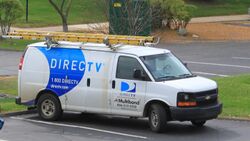
DirecTV was awarded a J.D. Power award for residential cable and satellite TV customer satisfaction in 2007.[124]
DirecTV's customer service is provided by many third-party owned call centers both inside and outside the United States. Most of the call centers are contracted to provide agents to answer customer phone calls regarding programming, billing, or technical questions.
(As of November 2012), DirecTV does not offer a 30-day grace period for those who wish to try the service. "If you do not fulfill your Programming Agreements, DirecTV may charge a pro-rated fee of up to $480."[125]
Better Business Bureau review
In August 2008, The Boston Globe reported that DirecTV received 20,000 complaints in less than three years to the Better Business Bureau on DirecTV slipping in cancellation fees.[126]
In August 2010, the BBB reported that it had received 39,000 complaints against DirecTV in the previous three years, and the BBB gave it an F (failing) grade. Many of the complaints concerned DirecTV's early termination fees, billing and service issues.[127]
International operations
- Sky PerfecTV! – sold to SKY Perfect JSAT Corporation
- DirecTV Latin America – renamed Vrio in 2018, sold to Grupo Werthein
- Sky Brasil – sold to Grupo Werthein
- Sky México – now part of AT&T Latin America (41.3%) and Televisa (58.7%)
See also
- High-definition television in the United States
References
- ↑ "About Us: Company Profile". DirecTV. http://www.directv.com/DTVAPP/content/about_us/company_profile.
- ↑ "AT&T & TPG Close DIRECTV Transaction". August 2, 2021. https://about.att.com/story/2021/att_directv.html.
- ↑ "AT&T Completes Acquisition of DirecTV". AT&T, Inc.. July 24, 2015. http://about.att.com/story/att_completes_acquisition_of_directv.html.
- ↑ Stelter, Brian (May 19, 2014). "AT&T and DirecTV strike $49 billion deal". CNN. https://money.cnn.com/2014/05/18/news/companies/att-directv/index.html.
- ↑ Gurwin, Jason (2021-04-22). "DirecTV, AT&T TV, and AT&T U-Verse Lost 620K Subscribers in Q1 2021" (in en-us). thestreamable.com. https://thestreamable.com/news/directv-att-tv-and-att-u-verse-lost-620k-subscribers-in-q1-2021.
- ↑ 6.0 6.1 Goldsmith, Jill (February 25, 2021). "WarnerMedia Parent AT&T Sells DirecTV Stake To Private Equity Firm TPG". https://deadline.com/2021/02/att-deal-directv-with-private-equity-firm-tpg-1234701305/.
- ↑ 7.0 7.1 Hayes, Dade (August 2, 2021). "AT&T Completes DirecTV Spinoff; Satellite Operator Unites Its Internet-Delivered Bundles Under New Brand DirecTV Stream". https://deadline.com/2021/08/att-directv-spinoff-tpg-streaming-bundles-warnermedia-1234807615/.
- ↑ Brinkly, Joel (1986-03-30). "The Richest Foundation". The New York Times. ISSN 0362-4331. https://www.nytimes.com/1986/03/30/magazine/the-richest-foundation.html.
- ↑ "Howard Hughes: Patron Of Science?" (in en). November 21, 2003. https://www.cbsnews.com/news/howard-hughes-patron-of-science-21-11-2003/.
- ↑ "G.M. Purchase Of Hughes". 23 December 1985. https://www.nytimes.com/1985/12/23/business/gm-purchase-of-hughes.html.
- ↑ "Hughes Electronics Corporation | American corporation" (in en). https://www.britannica.com/topic/Hughes-Electronics-Corporation.
- ↑ Fabrikant, Geraldine (1997-11-03). "Satellite TV Provider Waits for World to Catch Up (Published 1997)" (in en-US). The New York Times. ISSN 0362-4331. https://www.nytimes.com/1997/11/03/business/satellite-tv-provider-waits-for-world-to-catch-up.html.
- ↑ "Stanley S. Hubbard". https://www.pavekmuseum.org/HubbardSS.htm.
- ↑ Gross, Neil; Coy, Peter (1995-03-06). "The Technology Paradox" (in en). Bloomberg. https://www.bloomberg.com/news/articles/1995-03-05/the-technology-paradox.
- ↑ Richter, Paul (February 22, 1990). "New Satellite-to-Home TV Service Due in 1993 : Broadcasting: Four firms back -billion Sky Cable venture. The system could carry up to 108 channels". Los Angeles Times. https://articles.latimes.com/1990-02-22/news/mn-1704_1_cable-operator.
- ↑ POLETTI, THERESE (October 10, 1994). "NEW SATELLITE TV SERVICE OFFERED WITH 18-INCH DISH" (in en). https://buffalonews.com/news/new-satellite-tv-service-offered-with-18-inch-dish/article_59ef3c0c-7469-573d-9573-2bd40f5e9362.html.
- ↑ Behrens, Steve; Bedford, Karen Everhart (December 13, 1999). "DirecTV okays channels from PBS and ITVS". Current (American University School of Communication). http://current.org/wp-content/uploads/archive-site/in/in923d.html.
- ↑ "Cable Television Act of 1992--Program Distribution and Carriage Agreements". January 13, 1995. https://www.govinfo.gov/content/pkg/FR-1995-01-13/html/95-894.htm.
- ↑ Littleton, Cynthia (1997-11-12). "DirecTV commits: originals in" (in en-US). https://variety.com/1997/tv/news/directv-commits-originals-in-1108/.
- ↑ Cory Grice (December 14, 1998). "Hughes buys satellite firm for $1.3 billion". CNET news. http://news.cnet.com/Hughes-buys-satellite-firm-for-1.3-billion/2100-1033_3-219066.html.
- ↑ Joanna Glasner (January 22, 1999). "DirecTV Buys PrimeStar". Wired. https://www.wired.com/techbiz/media/news/1999/01/17479.
- ↑ Goetzl, David (1 May 2000). "Airlines and Airwaves". Advertising Age (New York City) 71 (19): 18–20.
- ↑ Nic Hopkins (April 10, 2003). "News Corp buys control of DirecTV". The Times (London). http://business.timesonline.co.uk/tol/business/article1128673.ece.
- ↑ "FCC OKs News Corp. purchase of DirecTV". MSNBC. December 19, 2004. https://www.nbcnews.com/id/3763546.
- ↑ "2004 Form 10-K, The DirecTV Group". U.S. Securities and Exchange Commission. March 17, 2004. https://www.sec.gov/Archives/edgar/data/944868/000119312505038986/d10k.htm.
- ↑ "DirecTV Agrees to Sale of PanAmSat Unit". L.A. Times. April 24, 2004. https://articles.latimes.com/2004/apr/21/business/fi-panamsat21.
- ↑ "2005 Form 10-K, The DirecTV Group, Inc.". U.S. Securities and Exchange Commission. March 10, 2006. https://www.sec.gov/Archives/edgar/data/944868/000104746906003209/a2168249z10-k.htm.
- ↑ "SkyTerra Communications Acquires Remaining Interest in Hughes Network Systems LLC from The DirecTV Group". SkyTerra Communications, Inc.. January 3, 2006. http://www.hughes.com/HNS%20Library%20Press%20Release/01-03-06_SkyTerra_acquires_remaining_interest_in_HNS_LLC_from_DirecTV.htm.
- ↑ 29.0 29.1 "The DIRECTV Group Announces Fourth Quarter and Full Year 2006 Results". DirecTV. http://investor.directv.com/releasedetail.cfm?ReleaseID=286317.
- ↑ Dempsey, John (2005-11-02). "DirecTV gets original with music show" (in en-US). https://variety.com/2005/music/news/directv-gets-original-with-music-show-1117932095/.
- ↑ "DirecTV to Pay $5.3 Million Penalty for Do Not Call Violations". Ftc.gov. 2011-06-24. http://www.ftc.gov/opa/2005/12/directv.shtm.
- ↑ David Lieberman (December 7, 2006). "Deal would give Liberty reins of DirecTV". USA Today. https://www.usatoday.com/money/media/2006-12-07-liberty-news_x.htm.
- ↑ "News Corp. Shareholders Accept Liberty Deal". The New York Times. April 4, 2007. https://www.nytimes.com/2007/04/04/business/media/04liberty.html.
- ↑ Tim Mullaney (February 27, 2008). "Liberty Completes Swap of News Corp., DirecTV Stakes". Bloomberg. https://www.bloomberg.com/apps/news?pid=newsarchive&sid=a4JFvml25M_8.
- ↑ John Eggerton (April 14, 2009). "FCC Approves Transfer of DirecTV's Station Licenses to Liberty Entertainment". Benton Foundation. http://benton.org/node/24265.
- ↑ "DirecTV to carry 100 National HD Channels in 2007". Engadgethd.com. http://www.engadgethd.com/2007/01/09/directv-to-carry-100-national-hd-channels-in-2007/.
- ↑ "D&M Holdings Divests ReplayTV". Dm-holdings.com. http://www.dm-holdings.com/eng/newsrelease/20071213_245.html.
- ↑ "DirecTV Takes Disputed Fees Out of Customer Accounts, Suit Charges". Consumer Affairs. September 25, 2009. http://www.consumeraffairs.com/news04/2009/09/directv_fees.html.
- ↑ Tim Mullaney and Kelly Riddell (May 4, 2009). "DirecTV Group to Combine With Liberty Entertainment". Bloomberg News. https://www.bloomberg.com/apps/news?pid=newsarchive&sid=auGzOOELO3.0.
- ↑ "DirecTV Completes Merger Transaction with Liberty Media". DirecTV. November 19, 2009. http://investor.directv.com/releasedetail.cfm?releaseid=425628.
- ↑ "New Satellite Services". DirecTV. June 16, 2010. http://newsatelliteservices.com/.
- ↑ "Why have the Music Channels changed?". DirecTV.com. http://support.directv.com/app/answers/detail/a_id/2641.
- ↑ Jim Moore (December 21, 2010). "Get ready for Root Sports, the next homer TV network". Seattle Post-Intelligencer. http://www.seattlepi.com/default/article/Get-ready-for-Root-Sports-the-next-homer-TV-914267.php#ixzz1JZsoKHEf.
- ↑ "Washington Attorney General's 1 million DIRECTV settlement sends clear signal". Atg.wa.gov. December 14, 2010. http://atg.wa.gov/pressrelease.aspx?id=26982.
- ↑ States reach $13.25 million settlement with DirecTV, Associated Press (December 18, 2010).
- ↑ $13.25 Multi-state Settlement Reached with DIRECTV over Allegations of Deceptive Advertising, Gant Daily (December 15, 2010).
- ↑ Key, Peter (June 5, 2013). "DirecTV buys firm backed by Michael Hagan". Philadelphia Business Journal. http://www.bizjournals.com/philadelphia/news/2013/06/05/directv-buys-firm-backed-by-michael.html.
- ↑ Flint, Joe (May 1, 2014). "AT&T interested in acquiring satellite broadcaster DirecTV". Los Angeles Times. https://www.latimes.com/entertainment/envelope/cotown/la-et-ct-directv-att-20140430,0,802533.story.
- ↑ de la Merced, Michael; Gelles, David (May 18, 2014). "AT&T to Buy DirecTV for $48.5 Billion". The New York Times. https://dealbook.nytimes.com/2014/05/18/att-to-buy-directv-for-48-5-billion/.
- ↑ "AT&T & DirecTV Merger Gets FCC Approval – With Conditions". July 24, 2015. https://deadline.com/2015/07/att-directv-merger-fcc-approval-1201484821/.
- ↑ "FCC approves AT&T–DirecTV merger". Vox Media. July 24, 2015. https://www.theverge.com/2015/7/24/8876267/att-directv-merger-approved.
- ↑ Kastrenakes, Jacob (March 11, 2015). "FTC alleges DirecTV deceptively advertised TV packages". Vox Media. https://www.theverge.com/2015/3/11/8191179/directv-deceptive-advertising-charges-ftc.
- ↑ Farrell, Mike (December 2, 2015). "AT&T Enters Next Phase in DirecTV Branding". MultiChannel News. http://www.multichannel.com/news/distribution/att-enters-next-phase-directv-branding/395664.
- ↑ Frankel, Daniel (December 2, 2015). "AT&T to begin transitioning away from DirecTV brand starting in January, report says". FierceCable. http://www.fiercecable.com/story/att-begin-transitioning-away-directv-brand-starting-january/2015-12-02.
- ↑ Bode, Karl (December 2, 2015). "AT&T Plans on Killing the DirecTV Name Starting in January". DSL Reports. http://www.dslreports.com/shownews/ATT-Plans-on-Killing-the-DirecTV-Name-Starting-in-January-135765.
- ↑ Moritz, Scott (February 16, 2016). "AT&T Takes U-Turn on U-Verse as It Pushes Users Toward DirecTV". Bloomberg. https://www.bloomberg.com/news/articles/2016-02-16/at-t-takes-u-turn-on-u-verse-as-it-pushes-users-toward-directv.
- ↑ Baumgarnter, Jeff (February 16, 2016). "AT&T Stops Making U-verse TV Boxes: Report". MultiChannel News. http://www.multichannel.com/news/distribution/att-stops-making-u-verse-tv-boxes-report/402596.
- ↑ Frankel, Daniel (February 16, 2016). "AT&T reportedly halts U-verse set-top production in latest DirecTV push". Fierce Cable. http://www.fiercecable.com/story/att-reportedly-halts-u-verse-set-top-production-latest-directv-push/2016-02-16.
- ↑ Baumgartner, Jeff (March 1, 2016). "AT&T to Take DirecTV Over-The-Top". MultiChannel News. http://www.multichannel.com/news/content/att-take-directv-over-top/402950.
- ↑ Kirsch, Nathan (March 1, 2016). "AT&T Allows DIRECTV Video Services Over a Your Internet Connection". Legit Reviews. http://www.legitreviews.com/att-allows-directv-video-services-internet-connection_179547.
- ↑ Lieberman, David (March 1, 2016). "AT&T Unveils DirecTV Streaming Video Plans With TV And Short-Form Content". Deadline Hollywood. https://deadline.com/2016/03/att-directv-streaming-video-services-plans-1201712085/.
- ↑ Baumgartner, Jeff (October 25, 2016). "DirecTV Now Coming in November". MultiChannel News. http://www.multichannel.com/blog/bauminator/directv-now-coming-november/408638.
- ↑ Singleton, Micah (2016-11-18). "DirecTV Now is holding a launch event on November 28th" (in en-US). https://www.theverge.com/2016/11/18/13676884/directv-now-launch-event-att-november-28th.
- ↑ Hammond, Ed; Sherman, Alex; Moritz, Scott (October 20, 2016). "AT&T Discussed Idea of Takeover in Time Warner Meetings". Bloomberg. https://www.bloomberg.com/news/articles/2016-10-20/at-t-said-to-discuss-idea-of-takeover-in-time-warner-meetings.
- ↑ Yu, Roger (October 20, 2016). "Report: AT&T considering buying Time Warner". USA Today. https://www.usatoday.com/story/money/2016/10/20/report-t-considering-buying-time-warner/92475270/.
- ↑ Hagey, Keach; Sharma, Amol; Cimilluca, Dana (October 21, 2016). "AT&T Is in Advanced Talks to Acquire Time Warner". The Wall Street Journal. https://www.wsj.com/articles/at-t-is-in-advanced-talks-to-acquire-time-warner-1477061850.
- ↑ Yu, Roger (October 22, 2016). "AT&T agrees to buy Time Warner for more than $80B". USA Today. https://www.usatoday.com/story/money/2016/10/22/reports-t-agrees-buy-time-warner-more-than-80b/92589816/.
- ↑ Gryta, Thomas; Hagey, Keach; Cimmiluca, Dana (October 22, 2016). "AT&T Reaches Deal to Buy Time Warner for $86 Billion". The Wall Street Journal. https://www.wsj.com/articles/at-t-reaches-deal-to-buy-time-warner-for-more-than-80-billion-1477157084.
- ↑ Lawler, Richard (July 13, 2017). "AT&T's 'next-gen' TV platform rollout will start on DirecTV Now". Engadget. https://www.engadget.com/2017/07/13/att-directv-now-next-gen/.
- ↑ Lieberman, David (July 13, 2017). "AT&T To Offer Cloud-Based DVR To Streaming Services". Deadline Hollywood. https://deadline.com/2017/07/att-offer-cloud-based-dvr-streaming-services-1202127918/.
- ↑ Frankel, Daniel (July 13, 2017). "DirecTV Now to finally get cloud DVR as part of AT&T video platform rollout". Fierce Cable. http://www.fiercecable.com/cable/directv-now-to-finally-get-cloud-dvr-as-part-at-t-video-platform-rollout.
- ↑ James, Meg (2019-07-30). "AT&T renames DirecTV streaming service AT&T TV Now" (in en-US). https://www.latimes.com/entertainment-arts/business/story/2019-07-30/att-changes-name-directv-now-to-att-tv-now.
- ↑ Brodkin, Jon (July 30, 2019). "AT&T kills DirecTV Now brand name as TV subscribers leave in droves". https://arstechnica.com/information-technology/2019/07/att-kills-directv-now-brand-name-as-tv-subscribers-leave-in-droves/.
- ↑ "AT&T changes DirecTV Now to AT&T TV Now". July 30, 2019. https://www.fiercevideo.com/video/at-t-changes-directv-now-to-at-t-tv-now.
- ↑ Catie Keck (August 19, 2021). "AT&T TV will officially become DirecTV Stream next week". https://www.theverge.com/2021/8/19/22633094/att-tv-directv-stream-august-26.
- ↑ Chris Kelly (September 9, 2022). "Campaign Trail: DirecTV tackles football, 'Real Housewives' fandoms". https://www.marketingdive.com/news/campaign-trail-directv-nfl-football-real-housewives-fandom/631288/.
- ↑ Ann-Christine Diaz (August 27, 2021). "SERENA WILLIAMS IS WONDER WOMAN IN FIRST CAMPAIGN FOR DIRECTV STREAM". https://adage.com/creativity/work/serena-williams-wonder-woman-directv-stream-ad/2361186.
- ↑ "DIRECTV To Present The Chairman's Party At Sofi Stadium, With Special Performance By 8-Time Grammy Winner Usher, On The BET Stage". January 27, 2022. https://www.lasec.net/directv-to-present-the-chairmans-party-at-sofi-stadium-with-special-performance-by-8-time-grammy-winner-usher-on-the-bet-stage/.
- ↑ "DIRECTV STREAM Completes Nationwide Rollout of Nearly 250 Local PBS Stations". February 16, 2022. https://www.pbs.org/about/about-pbs/blogs/news/directv-stream-completes-nationwide-rollout-of-nearly-250-local-pbs-stations/.
- ↑ Mookie Alexander (February 8, 2023). "Tyler Lockett to compete in American Cornhole League 'SuperHole' charity tournament". https://www.fieldgulls.com/2023/2/8/23591253/tyler-lockett-american-cornhole-league-superhole-charity-event-seahawks-news.
- ↑ Chris Kelly (April 7, 2023). "DirecTV succeeds with Brian Cox as 'Overly Direct Spokesperson'". https://www.marketingdive.com/news/directv-brian-cox-overly-direct-spokesperson-succession-campaign/647036/.
- ↑ "Our Partners". https://rmhc.org/about-us/our-partners.
- ↑ "DIRECTV Makes Long-Term Commitment To Support ChampionLA". January 13, 2022. https://www.lasec.net/directv-makes-long-term-commitment-to-support-championla/.
- ↑ "KITS Receives DirecTVxChampionLA Award at The Chairman's Party in Lead Up to Super Bowl LVI". February 15, 2022. https://www.kitsinc.org/post/kits-receives-directvxchampionla-award-at-the-chairman-s-party-in-lead-up-to-super-bowl-lvi.
- ↑ "Our Funders". https://www.hispanicfederation.org/our_funders/our_funders/.
- ↑ John Glenday (June 20, 2022). "DirecTV-Yahoo adtech partnership addresses fragmented digital video landscape". https://www.thedrum.com/news/2022/06/20/directv-yahoo-adtech-partnership-addresses-fragmented-digital-video-landscape.
- ↑ Karlene Lukovitz (October 17, 2022). "Yahoo, DirecTV Advertising Expand Deal To Include STB Data". https://www.mediapost.com/publications/article/378803/yahoo-directv-advertising-expand-deal-to-include.html.
- ↑ Lilliam Rizzo (August 23, 2022). "Amazon Prime signs deal with DirecTV to air 'Thursday Night Football' games in bars, restaurants". https://www.cnbc.com/2022/08/23/amazon-signs-deal-with-directv-to-air-thursday-night-football-games-in-bars.html.
- ↑ Brian Steinberg (February 16, 2023). "DirecTV To Provide Major League Soccer Games to Bars, Hotels for 2023 Season". https://variety.com/2023/tv/news/directv-tmajor-league-soccer-apple-1235525189/.
- ↑ Karlene Lukovitz (October 17, 2022). "Yahoo, DIRECTV Advertising Expand Deal To Include STB Data". https://www.mediapost.com/publications/article/378803/yahoo-directv-advertising-expand-deal-to-include.html.
- ↑ "Southwest Airlines & DIRECTV Partner Together to Serve Ronald McDonald House Charities". June 2, 2023. https://community.southwest.com/t5/Blog/Southwest-Airlines-amp-DIRECTV-Partner-Together-to-Serve-Ronald/ba-p/159453.
- ↑ "DIRECTV announces renewal, expansion of carriage agreement with NFL Media". June 27, 2023. https://www.nfl.com/news/directv-announces-renewal-expansion-of-carriage-agreement-with-nfl-media.
- ↑ "DIRECTV AND BIG TEN CONFERENCE ANNOUNCE LANDMARK SPONSORSHIP". August 29, 2023. https://btn.com/2023/08/29/directv-and-big-ten-conference-announce-landmark-sponsorship/#:~:text=BTN%20Communications%2C%20August%2029%2C%202023,most%20storied%20collegiate%20athletic%20conference..
- ↑ John Ourand (September 8, 2023). "DirecTV to offer 'Sunday Ticket' in P.R., USVI". https://www.sportsbusinessjournal.com/Articles/2023/09/08/nfl-sunday-ticket-puerto-rico-virgin-islands-directv.aspx.
- ↑ "DIRECTV Is Sponsoring Team USA in the 2023 World Baseball Classic". March 10, 2023. https://www.usabaseball.com/news/topic/professional/directv-is-sponsoring-team-usa-in-the-2023-world-baseball-classic.
- ↑ 96.0 96.1 96.2 "DirecTV and TiVo to Launch New HD DirecTV DVR with TiVo Service". DIRECTV. September 3, 2008. http://www.directv.com/DTVAPP/global/contentPage.jsp?assetId=P4900010.
- ↑ "MITRE TECHNICAL REPORT". April 2001. https://docs.fcc.gov/public/attachments/DOC-45704A1.txt.
- ↑ "Solid Signal goes "Hands On" with the new HR44 Genie DVR – The Solid Signal Blog". Forums.solidsignal.com. January 18, 2013. http://forums.solidsignal.com/showthread.php/3860-Solid-Signal-goes-quot-Hands-On-quot-with-the-new-HR44-Genie-DVR.
- ↑ Jon Fingas (July 19, 2019). "DirecTV Genie DVR and interface launch with advice for the indecisive". https://www.engadget.com/2012-10-11-directv-genie-dvr-and-interface-launch-with-advice-for-indecisive.html.
- ↑ 100.0 100.1 "History of RVU". https://rvuproject.org/history-rvu.
- ↑ "DIRECTV Genie 2 Product Manual". March 20, 2021. https://manuals.plus/directv/directv-genie-2-product-manual#google_vignette.
- ↑ "User Manual". https://www.att.com/ecms/dam/att/consumer/support/landingpage/userguides/pdf/ATT-TV-Device-Remote-Control-Manual.pdf.
- ↑ Jada Kennzie. "DirecTV just launched the Gemini Air—its new device for 4K content streaming". https://www.usatoday.com/story/tech/reviewed/2023/07/27/directv-stream-gemini-air/70478696007/.
- ↑ Poulsen, Kevin (2001-01-25). "DirecTV attacks hacked smart cards". Theregister.co.uk. https://www.theregister.co.uk/2001/01/25/directv_attacks_hacked_smart_cards/.
- ↑ "From the Eye of a Legal Storm, Murdoch's Satellite-TV Hacker Tells All". Wired. May 30, 2008. https://www.wired.com/politics/security/news/2008/05/tarnovsky?currentPage=all.
- ↑ Atwood, Jeff (2008-05-31). "Revisiting the Black Sunday Hack". Coding Horror. http://www.codinghorror.com/blog/2008/05/revisiting-the-black-sunday-hack.html.
- ↑ Huffstutter, P.J. (2001-01-27). "Satellite Blows TV Pirates Right Off the Tube". LA Times. https://www.latimes.com/archives/la-xpm-2001-jan-27-mn-17728-story.html.
- ↑ "DIRECTV TiVo – DIRECTV DVR with TiVo service – TiVo". TiVo. December 8, 2011. http://www.tivo.com/products/source/satellite/tivo-directv/.
- ↑ "HD DVR – Tivo® for DIRECTV". DirecTV. December 8, 2011. http://www.directv.com/DTVAPP/content/technology/tivo_receiver.
- ↑ "DirecTV launches 4K exclusive to Samsung TVs". https://www.cnet.com/news/directv-launches-4k-exclusively-to-samsung-tvs/.
- ↑ "DirecTV solves its 4K TV compatibility problem with new Genie Mini set-top boxes". IDG. http://www.techhive.com/article/2973627/video-players/directv-solves-its-4k-tv-compatibility-problem-with-new-genie-mini-set-top-boxes.html.
- ↑ "DirecTV's first live 4K show is the Masters golf tournament". https://www.engadget.com/2016/03/09/directv-first-live-4k-show/.
- ↑ "The Masters in 4K: DirecTV, CBS Sports Tee Up First Live 4K UHD Broadcast in U.S.". March 9, 2016. http://www.sportsvideo.org/2016/03/09/directv-tees-up-first-live-4k-production-at-the-masters/.
- ↑ "DirecTV to Carry MLB Network Games in 4K Ultra HD". April 12, 2016. https://variety.com/2016/digital/news/directv-mlb-4k-ultra-hd-1201751249/.
- ↑ "DirecTV To Offer Notre Dame Football Telecasts In 4K". September 8, 2016. http://www.multichannel.com/news/content/directv-offer-notre-dame-football-telecasts-4k/407605.
- ↑ "HD Locals". DirecTV. http://www.directv.com/DTVAPP/content/hd/hd_locals.
- ↑ 117.0 117.1 "DIRECTV AND PRIME VIDEO TO HOST THURSDAY NIGHT FOOTBALL". 23 August 2022. https://www.directv.com/insider/directv-and-prime-video-thursday-night-football/.
- ↑ Kohler, Katie (21 October 2021). "Joe Hand Promotions Still Fighting After 50 Years Thanks To Added Punch From Streaming, Barstool, and Streaming". Play Pennsylvania (Feasterville, PA: Catena Media). https://www.playpennsylvania.com/joe-hand-promotions-50-streaming-rough-rowdy/.
- ↑ Eli Blumenthal (May 25, 2023). "DirecTV Will Keep NFL Sunday Ticket in Bars, Restaurants and Hotels". https://www.cnet.com/tech/services-and-software/directv-will-keep-nfl-sunday-ticket-in-bars-restaurants-hotels/.
- ↑ Farhi, Paul. "Scene 1, Double Take 2" The Washington Post, August 7, 2007.
- ↑ Comcast Looks To Sack DirecTV's Sunday Ticket Campaign Multichannel News August 4, 2011
- ↑ Comcast Drops Suit Against DirecTV Over NFL Sunday Ticket Ads Multichannel News August 20, 2011
- ↑ "Client Highlights >> DirecTV". Lightships. http://www.lightships.com/tlgdirectv.php.
- ↑ DirecTV Sweeps J.D. Power Survey Cable360.net August 15, 2007
- ↑ Agreements DirecTV official site accessed November 4, 2012
- ↑ "DirecTV says its cancellation fee is fair since installation is free", The Boston Globe August 31, 2008
- ↑ "DirecTV Customer Service: Fail". http://www.bbb.org/us/post/directv-customer-service-fail-5588.
External links
 |
 KSF
KSF